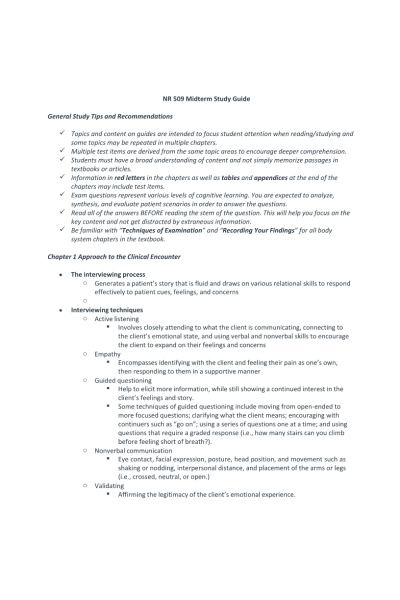NR 511 Week 4 Midterm Study Guide (Content Syllabus 2023)
-
$45.00
| Institution | Chamberlain |
| Contributor | Jenna James |
General Study Tips and Recommendations
- Topics and content on guides are intended to focus student attention when reading/studying and some topics may be repeated in multiple chapters.
- Multiple test items are derived from the same topic areas to encourage deeper comprehension.
- Students must have a broad understanding of content and not simply memorize passages in textbooks or articles.
- Information in red letters in the chapters as well as tables and appendices at the end of the chapters may include test items.
- Exam questions represent various levels of cognitive learning. You are expected to analyze, synthesis, and evaluate patient scenarios in order to answer the questions.
- Read all of the answers BEFORE reading the stem of the question. This will help you focus on the key content and not get distracted by extraneous information.
- Be familiar with “Techniques of Examination” and “Recording Your Findings” for all body system chapters in the textbook.
Chapter 1 Approach to the Clinical Encounter
- The interviewing process
- Interviewing techniques
- Setting the stage for the examination
- Establishing rapport
- Gender pronouns
- Patient-centered medical care
- The FIFE model
Chapter 2 Interviewing, Communication, and Interpersonal Skills
- Fundamentals of skilled interviewing
- Verbal and nonverbal communication
- Challenging patient situations and behaviors
Chapter 3 Health History
- Focused and comprehensive health histories
- Determining the scope of the patient assessment
- The seven attributes of a patient’s principal symptoms
- Subjective versus objective data
- Modifying of the clinical interview for various clinical settings
Chapter 4 Physical Examination
- Determining the scope of the physical examination
- Techniques of examination (Note: Be familiar with specific techniques in body system chapters)
- The head-to-toe physical assessment
Chapter 5 Clinical Reasoning, Assessment, and Plan
- The clinical reasoning process
- The problem list
- The differential diagnosis (DDx) list
- The summary statement
- Assessment (medical diagnoses)
- Planning (treatment and interventions)
Chapter 7 Evaluating Clinical Evidence
- Using elements of the physical examination as diagnostic tests
- Evaluating diagnostic tests
- Critically appraising clinical evidence
- Communicating clinical evidence to patients
Chapter 8 General Survey, Vital Signs, and Pain
- General survey
- Vital signs
- Classifying normal and abnormal blood pressures
- Acute and chronic pain
- Exploring weight loss (including anorexia nervosa and bulimia nervosa)
Chapter 9 Cognition, Behavior, and Mental Status
- Techniques of examination
- Speech patterns (including aphasia)
- Assessing abstract thinking
- Mental status examination
- Screening for depression
- Screening for substance abuse
- Hallucinations and illusions
Chapter 10 Skin, Hair, and Nails
- Techniques of examination
- Anatomy
- Skin lesion morphology
- Melanoma risk factors
- Health promotion and skin cancer screening
- Herpes zoster
Chapter 11 Head and Neck
- Techniques of examination
- Anatomy
• Lymph node assessment
• Thyroid assessment
• Screening for thyroid cancer
Chapter 12 Eyes
- Techniques of examination
- Anatomy
- Visual acuity assessment
- Visual fields assessment
- Extraocular muscle assessment (and associated cranial nerves)
- Ophthalmoscopic (funduscopic) examination and common findings
- Nystagmus
- Glaucoma
- Macular degeneration
Chapter 13 Ears and Nose
- Techniques of examination
- Anatomy
- Screening for hearing loss
- Nasal cavity and mucosa
- Sinus assessment
- Vertigo
- Tinnitus
- Rhinorrhea
- Otitis externa and otitis media
Chapter 14 Throat and Oral Cavity
- Techniques of examination
- Anatomy
- Oral cavity assessment
- Pharynx
- Carcinoma
- Grading tonsils (NOTE: Not in the textbook; see corresponding course lesson)
Chapter 15 Thorax and Lungs
- Techniques of examination (including percussion)
- Anatomy
- Respiratory distress
- Lung sounds
- Asthma
- Pneumonia
- Chronic obstructive pulmonary disease (COPD)
- Atelectasis
Chapter 16 Cardiovascular System
- Techniques of examination
- Anatomy
- Screening for cardiovascular (CV) risk factors
- Cardiovascular disease
- Lipid screening
- Heart rhythms and sounds
- Jugular venous pressure (JVP)
- Carotid arteries
- Murmurs
- Congestive heart failure (CHF)
- Heart valve pathology
Chapter 17 Peripheral Vascular System
- Techniques of examination
- Anatomy
- Lymph nodes
- Peripheral edema
- Peripheral pulses
- Chronic venous insufficiency
- Claudications
- Aneurysms
- Acute arterial occlusion
- Deep vein thrombosis (DVT)
| Instituition / Term | |
| Term | Uploaded 2023 |
| Institution | Chamberlain |
| Contributor | Jenna James |
























































